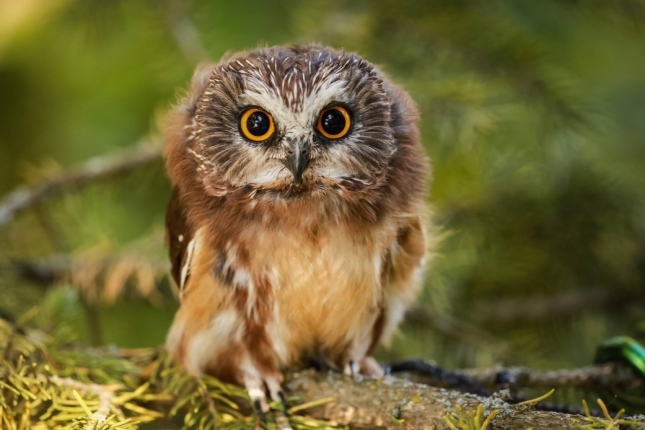
Photo courtesy of the Beaverhill Bird Observatory
Fun Facts About the Northern Saw-whet Owl
- The Northern Saw-whet Owl at 20 cm is the second smallest owl in Alberta next to the Northern Pygmy Owl, which measures 16 cm in length.
- The reddish-brown plumage on the upper parts is streaked with white around the face, and is splotched with white on the neck.
- The tail is banded with three bars, and the breast and abdomen are white with heavy brown streaks.
- Saw-whets inhabit the parkland, foothill, montane, and southern boreal mixed-wood forests.
- They prefer moist areas, alder thickets and tamarack bogs to drier deciduous areas.
- Saw-whets hunt mainly at dusk and dawn.
- Their main prey is mice and voles, but are also known to eat larger insects, songbirds, shrews and occasionally amphibians.
- For more information about the Northern Saw-whet Owl, visit allaboutbirds.org
Other Fun Facts About Owls
- Owls' feathers are especially soft and muffle wind noise.
- Many owls also have special comb-like fringes on the leading edge of their wings to help channel air, thereby reducing noise. These adaptations allow owls to make a soundless approach towards their prey.
- Many owls can turn their head around over 270º, allowing them to look almost directly behind themselves. This adaptation compensates for the fact that their eyes are fixed into a boney socket in the skull and are virtually unable to move.
- Owls' eyes are unique among birds as they are located on the front of the head, instead of on the side. This not only gives them a very human appearance but also enables them to match our level of depth perception that is created by the overlapping vision from each eye.
- Owls can fly and hunt during the daytime as well as at night. However most of them are best adapted for nocturnal hunting.
- Owls' ears are located asymmetrically on their head, with the right ear being higher than the left ear. Each ear hears the same sound with a slight difference, creating a form of audible “depth perception” which can be used to track the location and movements of their prey.
- After digesting their most recent meal, owls will form a pellet of the undigested remains of their prey and regurgitate it. Made up primarily of fur, feathers and bones, it is egested approximately 13-16 hours after eating.

